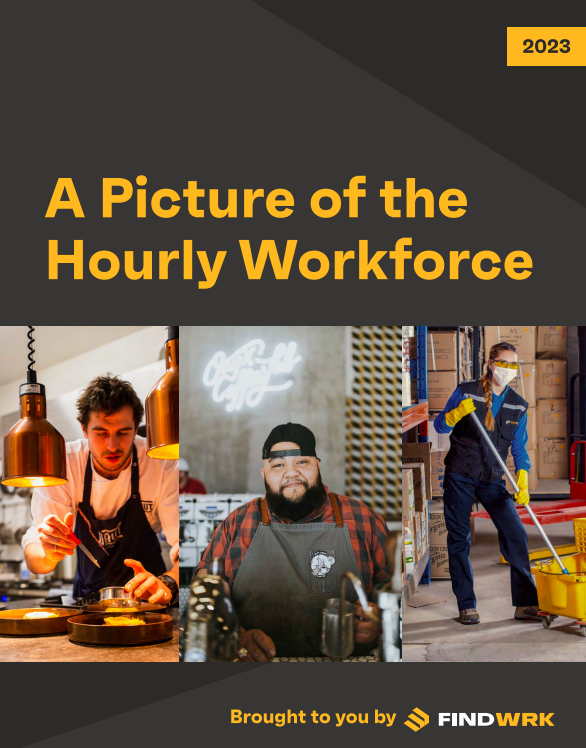Understanding the Canadian Hourly Workforce: A FindWRK Report (Part One)
The business world and increasingly so the foodservice industry is an highly competitive landscape, understanding the workforce at task, including the demographic, costs and expectations of the current pool is of critical importance to a business accomplishing its short and long term goals.
Workforce analysis is a process used to collect, analyze, and interpret data to assess the current state of the workforce – turning that information into actionable steps and strategies in your succession planning. The Canadian hourly workforce is a large and diverse group. Great employment relationships start with gaining a deeper understanding of the candidates whom you target.

FindWRK has conducted in-depth workplace analysis of the Canadian workplace in its 2023 Edition of a Picture of the Hourly Workforce. In part one of this series, we take a look into the size of the hourly workforce, demographics, segments and their respective career priorities.
“FindWRK was designed to provide efficiency without sacrificing human connection. In minutes you can build a shortlist of select candidates that meet your needs and canvas them for interest. Then connect directly with those that fit and have intent. The first connection made with the candidate is a human one. And you start your relationship off on the right foot.” says Michael Wallace, CEO FindWRK
The folks at FindWRK spend every day talking with workers, and understand how challenging the job search is, digging deeper into the worker experience with one mission – to find out why? Their research stems from the intersection of technology and the recruiting process. They found that, if done right, recruiting balances the digital and the human. But increasingly that human connection was being lost. This analysis explores the biggest trends in hourly work and offer solutions to these complex problems.
The Size of the Hourly Workforce
According to the report, the size of the hourly workforce has rebounded to pre-COVID levels, but continues to shrink relative to the size of the population – that means competition for great talent will continue and understanding your target candidate audience will be more important than ever. StatsCan estimates the Canadian workforce at roughly 18,000,000 workers, with over 60% paid hourly, versus an annual salary.

Hourly Worker Demographics
When it comes to hiring and retention, your focus must be on the individual. A one-size-fits-all approach will be inadequate to manage your hiring needs. According to FindWRK survey data starts by breaking down demographics. The report’s findings reveal that the majority are under 35, most are well-educated, and are more likely to be single and without children. Here is the breakdown:

Breaking the Workforce into Segments
So what exactly drives candidates to make career decisions? The answer may change for different segments of workers. FindWRK has identified three segments within the workforce, by looking into their career motivation, how workers structure their careers, and how they search for jobs.

The Career Hourly (30%)
- Primarily motivated to maintain employment to pay the bills.
- Generally older, with more than half over 35.
- More likely to stay longer in a role and priorities good management.
The New Canadian (25%)
- Primarily motivated to gain Canadian experience and establish themselves.
- Generally younger, with three quarters under 25.
- More likely to hold a single job while getting established.
Career Discoverer (45%)
- Primarily motivated to try out different career paths and opportunities.
- Generally younger, with three quarters under 35.
- The highest percentage of Ghosters – a term referring to the practice of prospective applicants and potential employees not “showing up” after being recruited
Identifying Career Priorities
If you want to secure talent, you have to understand the priorities of the hourly worker. This helps you define your approach from the day you write the first draft of your job post to your first days of mentoring and fostering trust with an employee. Generating income to cover expenses and career advancement are the highest priorities of the hourly workforce.

The 10,000,000+ hourly workers in Canada are a diverse group, and as we uncover what differentiates specific segments of the population to better connect with candidates and employee, we must now understand how candidates structure their career – the number of jobs they have, how often they move and what drives them to leave a job or select their next one.
In the next edition of this three-part series, we will reveal what the team at FindWrk have found on Career Structure and Mobility. Stay tuned and let FindWrk connect you with the right workers, fast.
FindWRK is a human-led platform that reimagines a more efficient way to recruit hourly workers.
To read the hourly worker report click here


